|
|
|
Sort Order |
|
|
|
Items / Page
|
|
|
|
|
|
|
| Srl | Item |
| 1 |
ID:
183142
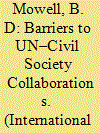

|
|
|
|
|
| Summary/Abstract |
In recent decades, civil society organizations (CSOs) have ostensibly attained increased access to the United Nations (UN) and other intergovernmental organizations (IGOs) and, in turn, increased opportunities for collaboration with IGOs. However, in most cases, CSO access to IGOs remains limited and highly regimented. Little scholarship has been undertaken to examine barriers to effective CSO–IGO collaborations. Virtually, no empirical research has examined the degree or nature of the interaction between the UN and international civil society via the dynamic of the flagship programme designed to facilitate such collaborations—the consultative status framework. This exploratory study partially addresses the latter gap in the scholarship by undertaking a qualitative macro-scale examination of CSOs within the UN Economic and Social Council’s (ECOSOC) consultative status programme, the primary vehicle in the UN–civil society dynamic. Specifically, the study sought to identify barriers to UN–civil society collaboration within the consultative status programme as perceived by participating CSOs. Findings of a survey sent to a random sample of 10% of CSOs holding UN–ECOSOC consultative status revealed that barriers to participation in the programme varied with some obstacles far more common than others. The degree of barriers reported by CSOs also strongly reflected the level of accreditation they held within the programme. Additionally, survey respondents offered insight as to how impediments in the collaboration could potentially be addressed.
|
|
|
|
|
|
|
|
|
|
|
|
|
|
|
|
| 2 |
ID:
153924
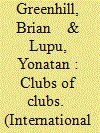

|
|
|
|
|
| Summary/Abstract |
Has international cooperation become fragmented in recent decades? We focus on a specific form of potential fragmentation in the international system: the extent to which the network of intergovernmental organizations (IGOs) consists of distinct clusters of closely cooperating states. IR scholars—including those with an interest in the causes and consequences of membership in IGOs—pay relatively little attention to the structure of the larger IGO network. At the same time, scholars concerned with fragmentation often assume that it has increased without clear measures of this phenomenon. We use the network analytic technique of modularity maximization to show that throughout the post–World War II period, the structure of the IGO network can generally be divided into distinct groups of states on the basis of their shared IGO memberships. Yet we also show that temporal trends indicate that the IGO network has become less fragmented in recent decades, suggesting that cooperation via these organizations has become more global and less regional. Our findings indicate that, at least as far as cooperation through formal organizations is concerned, fragmentation has decreased in recent decades.
|
|
|
|
|
|
|
|
|
|
|
|
|
|
|
|
| 3 |
ID:
180205
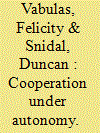

|
|
|
|
|
| Summary/Abstract |
Informal intergovernmental organizations (IIGOs) such as the Proliferation Security Initiative and G20 increasingly play a central role in governing international relations. IIGOs are based on recurrent meetings among high-level state representatives but are not legalized through a treaty and have no permanent secretariat. They allow states to organize internationally without sacrificing autonomy to a supranational entity. We present the IIGO 2.0 dataset, the most comprehensive compilation of these institutions to date, and illustrate the significance of IIGOs through several key empirical findings. First, while the creation of formal IGOs (FIGOs) has plateaued, states are increasingly creating IIGOs to address critical global issues. Second, states disproportionately use IIGOs for high politics issue areas including peace, security, and political agenda-setting which challenges conventional wisdom that IGOs (intergovernmental organizations) are less relevant in the security realm. Third, IIGOs are remarkably durable. Although states could readily formalize or abandon IIGOs, they generally organize cooperation informally for long periods. Finally, IIGOs are typically smaller than FIGOs and this design choice is increasingly used by states of all levels of development, power, and region. The availability of the IIGO 2.0 dataset will promote further analysis on the growing diversity of international institutions.
|
|
|
|
|
|
|
|
|
|
|
|
|
|
|
|
| 4 |
ID:
080976
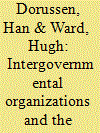

|
|
|
|
|
| Publication |
2008.
|
| Summary/Abstract |
The authors use network analysis to argue that the main contribution of intergovernmental organizations (IGOs) to international stability is not necessarily their direct and individual impact, because generally IGOs are institutionally weak. Rather, membership of IGOs creates network ties between states, allowing them, either individually or collectively, to intervene more effectively in latent conflicts. The IGO network also provides direct and indirect communication channels, where indirect links can act as partial substitutes for direct diplomatic ties. Empirically, the authors apply these ideas to the extensive network of international linkages created in the post-World War II period. They demonstrate that indirect links do indeed matter and that they substitute for more direct diplomatic ties. Furthermore, these effects are not limited to ties created by IGOs with specific security functions
|
|
|
|
|
|
|
|
|
|
|
|
|
|
|
|
| 5 |
ID:
172155
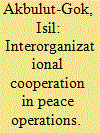

|
|
|
|
|
| Summary/Abstract |
This study proposes a network approach to interorganizational cooperation in peace operations. It suggests that in addition to key organisational characteristics that are already established in the literature, such as organisational type, the nature of relationships among intergovernmental organisations (IGOs) drives the formation and evolution of inter-IGO networks in peace operations. To evaluate my hypotheses, I use the temporal exponential random graph model (TERGM). The empirical analysis provides evidence that the formation of interorganizational networks among IGOs in peace operations is largely driven by relational effects, e.g. network effects.
|
|
|
|
|
|
|
|
|
|
|
|
|
|
|
|
| 6 |
ID:
156662


|
|
|
|
|
| Summary/Abstract |
Existing work has shown that membership in intergovernmental organizations (IGOs) can, among other outcomes, reduce conflict, promote democratization, and shape crisis bargaining. The traditional approach to studying how IGOs can reduce conflict has focused on the effects of dyads’ direct ties to IGOs. In doing so, these analyses use fairly simple counts of the number of IGOs to which the states in each dyad share membership. We argue that this approach is too narrow; we instead consider the effects of higher-order groupings within the IGO network, which we call IGO clusters. Within these IGO clusters, states share relatively many IGO connections with each other, both directly and through indirect links through third parties, fourth parties, and so on. The effects of indirect IGO ties are especially important within such structures. We use a modularity maximization approach to detect clusters within the IGO network. We find robust empirical support for our hypothesis that the pacifying effect of IGO membership stems from the extent to which pairs of states are more deeply embedded within the wider IGO network. Indeed, we find that once we account for states’ shared membership in clusters of IGOs, the simpler dyadic measure of shared IGO membership no longer shows evidence of a conflict-inhibiting effect.
|
|
|
|
|
|
|
|
|
|
|
|
|
|
|
|
| 7 |
ID:
092343
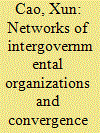

|
|
|
|
|
| Publication |
2009.
|
| Summary/Abstract |
We studied three potential causal mechanisms through which network dynamics of intergovernmental organizations (IGO) might cause convergence in domestic economic policies. First, IGO networks facilitate policy learning by providing relevant information. Second, they encourage policy emulation by creating a sense of affinity among countries that are closely connected by IGO networks. Finally, some powerful IGOs ''coerce'' their member states to adopt certain policies. We used causal modeling to test the relationships between different types of IGOs (and the causal mechanisms to which they mostly correspond) and policy convergence. The findings demonstrate the important roles played by salient IGOs such as the WTO, the EU, and the OECD, with each of them having a strong converging effect on their member states' domestic economic policies. More interestingly, we find that the cumulative effects of multiple layers of even the weakest types of IGOs have strong causal effects on states' domestic policies. Indeed, the shared memberships in IGOs with economic functions and with the minimal level of institutional capacity are not only statistically associated with, but also have converging causal effects on, countries' domestic policies. This supports the information-driven policy learning mechanism. The emulation mechanism in which IGO networks create a sense of affinity and therefore facilitate policy diffusion and convergence, on the other hand, is not supported by empirical analysis.
|
|
|
|
|
|
|
|
|
|
|
|
|
|
|
|
| 8 |
ID:
146185
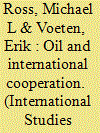

|
|
|
|
|
| Summary/Abstract |
The more that states depend on oil exports, the less cooperative they become: they grow less likely to join intergovernmental organizations, to accept the compulsory jurisdiction of international judicial bodies, and to agree to binding arbitration for investment disputes. This pattern is robust to the use of country and year fixed effects, to alternative measures of the key variables, and to the exclusion of all countries in the Middle East. To explain this pattern, we consider the economic incentives that foster participation in international institutions: the desire to attract foreign investment and to gain access to foreign markets. Oil-exporting states, we argue, find it relatively easy to achieve these aims without making costly commitments to international institutions. In other words, natural resource wealth liberates states from the economic pressures that would otherwise drive them toward cooperation.
|
|
|
|
|
|
|
|
|
|
|
|
|
|
|
|
| 9 |
ID:
116424
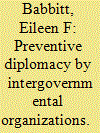

|
|
|
|
|
| Publication |
2012.
|
| Summary/Abstract |
Abstract Conflict prevention is enjoying a renaissance in international policy circles. However, the official machinery of the international community presently offers few institutions with a specific mandate to address the causes of political violence at an early stage. One such multilateral mechanism dedicated solely to the prevention of conflict is the High Commissioner on National Minorities (HCNM) of the Organization for Security and Co-operation in Europe (OSCE). Over two decades, the office has developed a significant track record of effectiveness against which to examine the preventive efforts of other intergovernmental organizations. In this article, we examine the prevention efforts of the HCNM in Georgia, Macedonia, and Ukraine and compare these with the preventive diplomacy of three other intergovernmental organizations (IGOs): the Organization of American States (OAS) in Guyana, the Commonwealth in Fiji, and the UN in Afghanistan, Burundi, and Macedonia. Our findings offer some useful and surprising insights into effective prevention practice, with implications for how IGOs might improve preventive diplomacy in the future.
|
|
|
|
|
|
|
|
|
|
|
|
|
|
|
|
| 10 |
ID:
139527


|
|
|
|
|
| Summary/Abstract |
Do intergovernmental organizations (IGOs) screen out conflict-prone states? We argue that IGOs have incentives to guard against admitting new members that pose significant security risks. Using a data set based on state–IGO pairings, we find clear evidence of screening: As security risk increases, the probability of IGO membership declines. Our findings underscore the importance of accounting for possible selection bias when studying the effects of IGO membership on conflict. Indeed, the types of IGOs sometimes found to be most effective at promoting peace—namely highly institutionalized organizations and those with a security mandate—also prove particularly selective and sensitive to risk.
|
|
|
|
|
|
|
|
|
|
|
|
|
|
|
|
| 11 |
ID:
099121
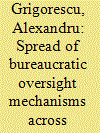

|
|
|
|
|
| Publication |
2010.
|
| Summary/Abstract |
The study asks why so many intergovernmental organizations (IGOs) have established recently offices and policies intended to facilitate the oversight of their bureaucracies. It begins from a set of hypotheses derived from the principal-agent (PA) literature, a natural starting point for answering this question. It then considers explanations based on norms and institutional diffusion to offer a more complete explanation of developments. The study argues that the empowerment of democratic norms and institutional diffusion processes across IGOs have altered member-states' preferences and allowed them to overcome collective action problems involved in the adoption of oversight mechanisms. The hypotheses are tested across more than 70 organizations. The results suggest that arguments extracted from the PA literature and the one on norms allow us to understand which IGOs are more likely to have bureaucratic oversight mechanisms. On the other hand, models that also take into account diffusion processes allow us to understand better when such mechanisms are adopted.
|
|
|
|
|
|
|
|
|
|
|
|
|
|
|
|
| 12 |
ID:
142426


|
|
|
|
|
| Summary/Abstract |
The 70th anniversary of the signing and entry into force of the United Nations Charter provides a good moment to revisit the conditions under which Allied governments decided to establish the second generation of intergovernmental organization. The wartime commitments to defeating fascism and multilateralism made the establishment of the world organization a logical outgrowth of the wartime origins and the best guarantee of peace and prosperity. Ironically, the ideals of Immanuel Kant were found to be essential to the Hobbesian objective of state survival; multilateralism was a powerful strategy and not merely liberal window-dressing. That historical backdrop is complemented by two largely invisible variables from that time—the role of ideas and of non-state actors—which have since been driving change in the world organization. A future research agenda suggests ways to lift the UN from its current doldrums. Many of the debates and operational activities in the United Nations beginning in the 1970s reflected two topics—interdependence and the proliferation of actors—which profoundly affected what, since the 1990s, we have come to call ‘global governance’. On the positive side, these preoccupations helped us move towards a better understanding of a very complex world. On the downside, they also tend to celebrate unduly the ability of non-state actors and ignore the crucial role of intergovernmental organizations.
|
|
|
|
|
|
|
|
|
|
|
|
|
|
|
|
|
|
|
|
|